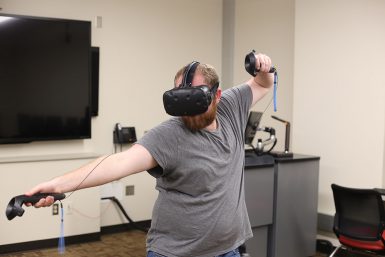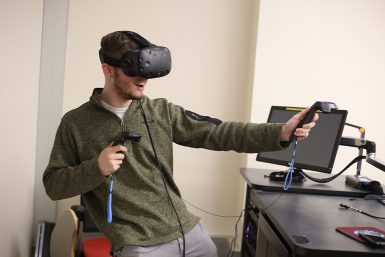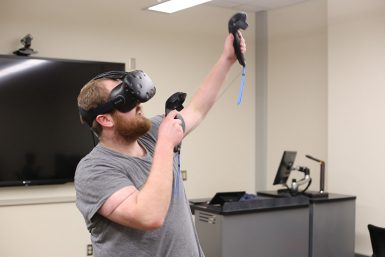School’s virtual reality lab offers full range of techniques

You’re in front of a car, trying to change the headlight. You walk over to grab it, but you run into something invisible to you. To any onlooker, you resemble a zombie walking around with your hands in front of you to avoid running into anything else.
You take off your headset only to realize you just walked into a chair, and you’re actually in the Franklin Hall game lab.
The virtual reality lab provides a venue for students and researchers to access a full range of VR equipment to refine techniques for creating and learning about video games and developing innovative ways to use them.
“At the highest level, virtual reality is about entering completely into a crafted space, a place made by humans,” said professor Ted Castronova, director of the game design program at the school. “What the technology allows is for digital artwork and sound to replicate any type of 3D environment, then present that to your eyes and ears in an intimate way.”
The lab houses some of the most newest equipment in the industry, including an HTC Vive with headset, two wireless controllers and two base stations that facilitate 360-degree room-scale motion tracking.
“This new wave of virtual reality products on the market didn’t really commence until last April, so it hasn’t even been a full year since these have appeared on the market,” said Chabane Maidi, game lab director at the school.
As for the experience itself, instead of the game environment on a screen in front of you, it’s right on your head. The headset isn’t very heavy, and you don’t have cables attached leading to computers. You have what feels like a heavy hat on that allows you to enter a world completely inside the game.

In addition to the lab, Franklin Hall 052 has 10 sets of virtual reality equipment for students in classes that work with virtual reality, including a virtual reality-specific class set for this fall. This equipment is available for checkout when not in use in classes.
The classroom is a partnership between The Media School and IU’s University Information Technology Services. Jay Kincaid, the school’s director of facilities and technology, worked with UITS to fund the room. “It opens us up to the entire campus, and we benefit from it being in our building,” said Kincaid. “This also opens up a lot of doors with other schools, too.” Departments including fine arts and informatics are interested in incorporating virtual reality in to their curriculums as well.
Prompted by increased interest in university departments and recent developments in virtual reality, IU’s University Information Technology Services team assists in incorporating the technology into learning spaces on campus. Julie Johnston, director of learning spaces at IU; Eric Wernert, director of visualization and analytics and research technologies; and Michael Boyles, manager of the Advanced Visualization Lab, helped plan the learning spaces and get the new technology to the school.
“We are committed to providing a quality, high-end technology experience for students,” said Johnston. “I think VR is a good example of that. You can’t experience the world in the way that VR lets you experience it without the technology. After leaving campus, students can say they have had a wide variety of technological experiences that enhanced their education.”
Students can use virtual reality to create game content for systems and have immediate feedback. Others can test their games and critique the work all in the same place.
Virtual reality does have uses beyond games, however. It can inform design, for example, for environments or spaces. It an enable engineers to test theories. It can expand the information in journalism and film.
“There are two broad categories we talk about: those who are interested in making their own worlds and those who are interested in simply using worlds or environments others have created,” said Eric Wernert, director of visualization and analytics and research technologies.

Both categories can be explored in The Media School virtual reality lab. Students have the opportunity to use the technology to create their own worlds within virtual reality or demo worlds fellow students and designers have created.
Getting this technology into The Media School is about demystifying it. The more students who have access, the more people will be inclined to learn about how it can be integrated into their own fields.
“It’s really about accessibility. That’s the key here,” said Michael Boyles. “What we’re doing now is just providing access to more students than ever.”
Just as smartphones went through a hype cycle, virtual reality will, too. Castronova predicts that in five years, it will be a part of our everyday lives, and in 10 years it will just be another form of technology, like laptops and smartphones.
“We’re not merely following the trends, but we’re also thinking prudently about what to build, what to make because I know the impression sometimes out there is that we’re always clamoring for whatever shiny toy is out there,” said Castronova. “We do vet what we’re getting pretty carefully. We watch the hype.”
More:

